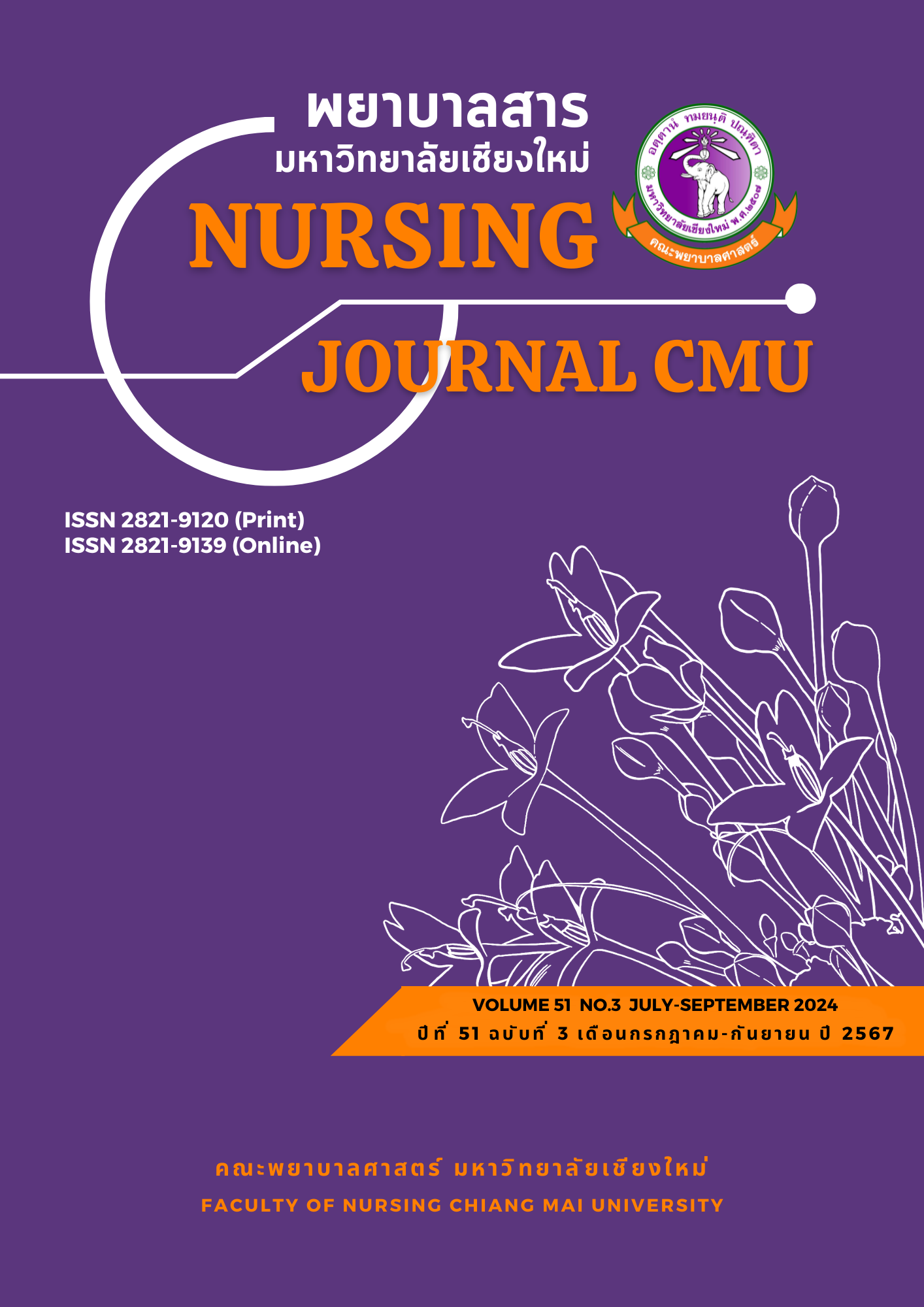Nurses’ Competency in Caring for Patients with Incontinence-Associated Dermatitis
Keywords:
Nurses’ competency, Incontinence-associated dermatitis, Medical wardAbstract
Incontinence-Associated Dermatitis (IAD) is a condition in which there is inflammation of the skin from contact with urine or stool. It is a common condition in elderly and chronically ill patients who cannot control their continence. This descriptive research aimed to examine the level of nurses’ competency in caring for patients with IAD. Study participants included 253 registered nurses working in medical wards in the 4th Public Health Region. The instruments used for collecting data included: 1) a demographic data form, and 2) the scale of competency in caring for patients with IAD (SC-IAD). The SC-IAD was tested for content validity by five experts and received a Content Validity Index (CVI) of 1.00. The reliability was tested among 30 registered nurses and yielded a Cronbach’s alpha of .98. The data were analyzed using descriptive statistics.
The results showed that nurses’ competency in caring for patients with IAD was at a moderate level (M = 179.63, SD = 38.16). When considering each dimension, it was found that only nursing practice competency was at a high level (M = 63.86, SD = 11.05), while competency in other dimensions was at a moderate level.
The results of this study can be used as basic information to improve nurses’ competency in caring for patients with IAD to enhance the quality of care.
References
Benner, P. (1982). From novice to expert. American Journal of Nursing, 82(3), 402-407. https://journals.lww.com/ajnonline/citation/1982/82030/from_novice_to_expert.4.aspx
Bliss, D. Z., Funk, T., Jacobson, M., & Savik, K. (2015). Incidence and characteristics of incontinence-associated dermatitis in community-dwelling persons with fecal incontinence. Journal of Wound, Ostomy, and Continence Nursing, 42(5), 525-530. https://doi.org/10.1097/WON.0000000000000159
Bliss, D. Z., Savik, K., Thorson, M. A. L., Ehman, S. J., Lebak, K., & Beilman, G. (2011). Incontinence-associated dermatitis in critically ill adults: Time to development, severity, and risk factors. Journal of Wound Ostomy & Continence Nursing, 38(4), 433-445.
Dongpho, P. (2019). Effectiveness of clinical practice guidelines implementation for pressure sore preventation. Thammasat Medical Journal, 19(2), 315-323. (inThai)
Gray, M., Beeckman, D., Bliss, D. Z., Fader, M., Logan, S., Junkin, J., Selekof, J., Doughty, D., & Kurz, P. (2012). Incontinence-associated dermatitis: A comprehensive review and update. Journal of Wound Ostomy & Continence Nursing, 39(1), 61-74. https://doi.org/10.1097/WON.0b013e31823fe246
Gray, M., & Giuliano, K. K. (2018). Incontinence-associated dermatitis, characteristics and relationship to pressure injury: A multisite epidemiologic analysis. Journal of Wound, Ostomy, and Continence Nursing, 45(1), 63-67. https://doi.org/10.1097/WON.000000000000039
Johansen, E., Bakken, L. N., Duvaland, E., Faulstich, J., Hoelstad, H. L., Moore, Z., Vestby, E. M., & Beeckman, D. (2018). Incontinence-Associated Dermatitis (IAD): Prevalence and associated factors in 4 hospitals in Southeast Norway. Journal of Wound Ostomy & Continence Nursing, 45(6), 527-531. https://doi.org/10.1097/won.0000000000000480
Lumbers, M. (2019). How to manage incontinence-associated dermatitis in older adults. British Journal of Community Nursing, 24(7), 332-337. https://doi.org/10.12968/bjcn.2019.24.7.332
Ministry of Public Health. (2020). Report on the performance of the 4th health distric for fiscal year 2020. https://rh4.moph.go.th/upload/c4cd180c52eec726c3d84c75a452f30d.pdf
Ngamkala, T., Malathum, P., & Krairit, O. (2018). Incidence and risk factors of acute confusional state in hospitalized older patients. Ramathibodi Nursing Journal, 24(2), 137-149. https://www.rama.mahidol.ac.th/ramanursej/rnj-v24-no2-may-aug-2018-03 (in Thai)
Phungsiri, P. (2016). The effect of utilizing work instruction for incontinence associated dermatitis in high risk patient. Region 11 Medical Journal, 30(1), 59-67. (in Thai)
Rajavithi Hospital. (2017). Statistical report 2017. http://www.rajavithi.go.th/rj/wp-content/uploads/2019/02/stat2560.pdf
Rizany, I., Hariyati, R. T. S., & Handayani, H. (2018). Factors that affect the development of nurses’ competencies: A systematic review. Enfermeria Clinica, 28, 154-157. https://doi.org/10.1016/S1130-8621(18)30057-3
Sulaiman, N., Sae-Sia, W., & Promnoi, C. (2020). Selected factors for predicting nurses’ competency towards the prevention of incontinence-associated dermatitis (IAD) in critically ill patients. Thai Journal of Cardio-Thoracic Nursing, 31(2), 174-186. (in Thai)
Uppanisakorn, S., Sommai, T., Vattanaprasan, P., & Boonyarat, J. (2015). Prevention and treatment of Incontinence-Associated Dermatitis (IAD) in critical patients treated in the intensive care unit of a medical ward. Thai Journal of Nursing Council, 30(2), 86-100. (in Thai)
Wound, Ostomy and Continence Nurses Society Task Force. (2018). Wound, ostomy, and continence nursing: Scope and standards of WOC practice, 2nd Edition: An executive summary. Journal of Wound, Ostomy, and Continence Nursing, 45(4), 369–387. https://doi.org/10.1097/WON.0000000000000438
Downloads
Published
How to Cite
Issue
Section
License
Copyright (c) 2024 Nursing Journal CMU

This work is licensed under a Creative Commons Attribution-NonCommercial-NoDerivatives 4.0 International License.
บทความที่ได้รับการตีพิมพ์เป็นลิขสิทธิ์ของวารสารพยาบาลสาร
ข้อความที่ปรากฏในบทความแต่ละเรื่องในวารสารวิชาการเล่มนี้เป็นความคิดเห็นส่วนตัวของผู้เขียนแต่ละท่านไม่เกี่ยวข้องกับมหาวิทยาลัยเชียงใหม่ และคณาจารย์ท่านอื่นๆในมหาวิทยาลัยฯ แต่อย่างใด ความรับผิดชอบองค์ประกอบทั้งหมดของบทความแต่ละเรื่องเป็นของผู้เขียนแต่ละท่าน หากมีความผิดพลาดใด ๆ ผู้เขียนแต่ละท่านจะรับผิดชอบบทความของตนเองแต่ผู้เดียว






